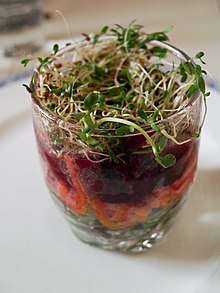Verrine
- For the demon, see Verrine (demon). For Cicero's Verrines, see In Verrem.

A verrine is a small, thick-walled glass container with no base, whose purpose is to hold a solid or liquid dish (starter, main course or dessert) rather than a drink.[1] This French word is usually left untranslated.[2]
Metonymously, a "verrine" designates in the cooking world a dish served in a verrine, in a vertical manner, allowing a different aesthetic and gustatory experience compared to a dish served on a plate.
Philippe Conticini was the first (in 1994) to imagine a dessert served in a verrine.[1] He introduced more than a simple evolution of the form, but rather a notable evolution in taste experience.
The verticality and transparency of the verrine allows:
- Immediate visual reading and construction of taste, and
- Completion of the gustatory balance in the mouth rather than in the verrine; sensations of intensity and finish are strengthened and better controlled by the experiencer.
According to the original concept, verrines are composed of three layers, each conveying specific taste characteristics:
- The lower, thin layer is made of an acidic preparation to trigger salivation and prepare the taste buds to receive other tastes
- The intermediate, thicker layer consists of a preparation bringing the "main flavor"
- The upper layer consists of a smooth and silky preparation aimed at coating the taste buds and providing a full-bodied, pleasant finish.
References
| Wikimedia Commons has media related to Verrine. |
- 1 2 Larousse Gastronomique, p. 887 left column, article "verrine" (French)
- ↑ wiktionary:verrine